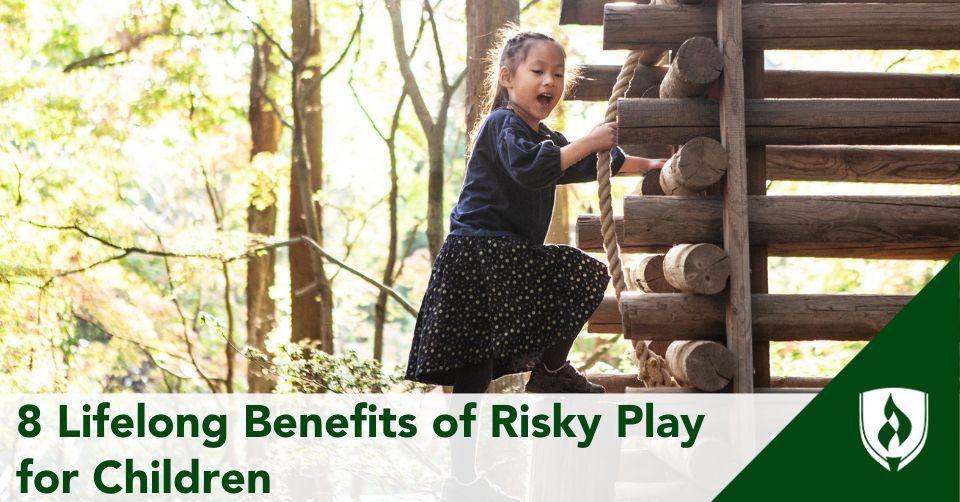
Children learn and grow through exploration, and sometimes that means taking risks. But it's hard to know what kind of risks are okay to allow.
As a parent, a caregiver, a teacher or a childcare provider, your number one priority tends to be the safety of the children you love. But you also know their growth, health and long-term happiness includes teaching them how to take reasonable risks and navigate the world.
Risky play is the kind of adventurous activity that makes adults a little nervous, like climbing, balancing, or even some roughhousing. Yet these experiences are not only safe when guided, but also essential for healthy child development.
From building confidence to improving physical literacy, risky play helps children discover their own limits while gaining skills that last a lifetime.
What is risky play?
In early childhood education, risky play refers to activities that involve a sense of challenge or adventure, where children test their abilities and learn to navigate uncertainty.1
“Risk is really when children do something where they do not know the outcome,” says Dr. Mary Muhs, Dean of the Early Childhood Education degree programs at Rasmussen University.
“To a child, most risky play can be a part of their daily life,” she adds.
It’s not about putting kids in harm’s way. Instead, it’s about encouraging appropriate risk taking—the kind that stretches skills and builds confidence without exposing children to serious danger.
Examples of risky play activities
Risky play includes activities children are often eager to try, like climbing a tree or running down a grassy hill, according to Joni Kuhn, ECE instructor at Rasmussen University. Some of these things may seem unsafe to adults but are actually healthy risks when the potential outcomes are understood and supervised appropriately.
- Climbing a tree
- Climbing a play structure
- Balancing on a log
- Riding a bike
- Roughhousing with friends
- Tackling or wrestling
- Jumping across obstacles
By creating opportunities for adventurous play in safe, supportive environments, parents and educators allow children to experience the thrill of discovery while learning how to manage risk responsibly.
8 Benefits of risky play in child development
Children grow best when they have chances to explore, test and challenge themselves. Risky play supports many areas of child development and offers benefits that support children through their entire lives.2
1. Risky play supports physical development
Climbing, running and balancing build strength, coordination and physical literacy.
It's not just about the health benefits of physical activity that adults might think of. These activities also help children develop motor skills they’ll rely on through every stage of growth.
“Children build balance, coordination, spatial awareness and strength through these activities—often without realizing it,” explains Dr. Muhs. The body and brain and experience of consciousness are all connected.
Think about something like outdoor free play. If you allow children to run about and play as they like in an outdoor area, you'll see them engage in all sorts of active play. Trying to climb things, looking behind and under things, trying to lift or move something heavy, trying to balance, jump and run.
As they do this, they develop muscle and coordination that supports children's health for their entire lives. They are learning how to use their bodies in the world and learning how to avoid more serious physical injury.
Let's say a child tries balancing on the edge of a playground, wobbles and falls. If the drop isn't too much, they will walk away with a bump or a scratch—but also with a new awareness of height and understanding the risk of falling. This knowledge can protect them from more dangerous falls later on.
Children's risky play is about allowing them to experience risk, reward, and also failure in ways that teach them.
2. Risky play deepens their emotional resilience
Risky play encourages children to manage feelings like excitement, fear and frustration. If you've ever watched children play sports together or do anything physical, you've likely witnessed plenty of tears, anger, jubilation and high emotions in general.
The increased sense of danger that comes with risky play can bring out a child's biggest emotions. They might be terrified they can't do it. They might be overconfident or rude. They might be furious or upset at failure. All of this is so good for their emotional development.
“Increased self-confidence and reduced anxiety are two of the biggest emotional benefits,” says Kuhn. “When children try something they think they can’t do—but find out they can—it changes how they view themselves.”
Over time, they build resilience and confidence as they realize they can overcome challenges.
Children who learn to try new things, fail and try again develop the understanding that failure is not the end of the world. Failure is normal. This kind of awareness needs to be learned through direct experience.
3. Risky play helps them think and evaluate
How many times have you hollered something like "Be careful!" in the direction of your kids? It's probably because you, as an adult, can foresee what could go wrong/what is dangerous about their current activity. But how did you first learn to evaluate that?
When children assess a new climbing route or decide how high to swing, they practice problem-solving and risk management skills that sharpen decision-making.
Picture a child attempting to climb up to the monkey bars on a playground. They realize at the top of the ladder that they cannot reach the first rung of monkey bars. At this moment, they have two choices. Climb back down or attempt to jump to the rung.
These moments allow children to evaluate situations, think strategically and understand consequences, skills that build sound judgment over time, according to Dr. Muhs.
If adults whisk the child off the monkey bar ladder right away, knowing the child won't be able to reach, they deprive the child of that chance to evaluate. Even though children aren't as aware of potentially dangerous elements as adults are—they don't want to get hurt either.
4. Risky play teaches empathy and awareness
When kids engage in risky play, they learn that if they don't pay attention to what they are doing, they might hurt or frustrate another child.
Let's say some kids are roughhousing as they play. Those kids are learning that smashing into one another often hurts both themselves and the other child. They learn that pushing someone causes them to stumble or fall forward. Then they see how that causes other children to react in anger or sadness.
They learn when a friend is enjoying the game and when to ease up, practicing empathy and respect for others’ limits, Muhs explains.
Adults often want to jump in to prevent tears or shouting matches. But allowing children to see the impact of their actions matters for their development.
The thrill of exciting play isn’t just fun. It’s also one of the earliest ways to support children’s social-emotional health.
5. Risky play motivates children to cooperate and negotiate
Many forms of adventurous play, such as rough and tumble play or building with natural materials, require cooperation. Children learn to negotiate rules, share space and respect others’ boundaries. They might learn that some risk taking goes better when they have another child to help.
Building a fort from loose parts or figuring out how to climb a structure safely requires teamwork. In these moments, children learn to share ideas, divide tasks and support each other’s efforts.
Depending on the type of risk, they may also strengthen their social and language skills by negotiating rules, compromising and working as part of a team, according to Dr. Muhs.
6. Risky play shows children they can handle hard things
If you never fail, failure is terrifying. Failure might mean you aren't who you thought you were, that you can't handle things, that life is too hard for you. Risk taking is part of how you realize that failure is okay. You can still be a good person, a smart person, a strong person and fail.
“When kids learn to trust themselves and take initiative, they develop a positive self-concept,” Dr. Muhs explains. Instead of relying on their circumstances or the people around them to provide their sense of worth, they build their own internal sense of worth.
Risky play helps children prove to themselves that they can face new challenges. Each time they succeed—whether it’s balancing on a beam or trying a new speed—they gain self-assurance that carries into other parts of life.
7. Risky play helps children learn self-control
As you can see, risky play does a lot for a child's confidence and sense of identity. It also helps them learn their limits (which sometimes are also just the limits of the human body and like, physics).
When a child climbs a little higher than they ever have before or races a friend down a hill, they are experiencing a rush of excitement and a test of self-control, according to Kuhn. These small moments of risk can have a lasting impact.
“Risky play can be looked at as managed safety,” Kuhn explains. “It helps children develop independence and physical abilities that can’t always be built through ‘playing it safe.’”
Through trial and error, children learn what feels safe and when to pause. Knowing their own limits is a key skill that helps prevent reckless decisions later on.
8. Risky play can support children against anxiety disorders
Children's mental health isn't a topic you hear about as often as other types of development. But it's a huge element in their experience of life in the moment, as well as what they will experience in the future.
Risky play can have an immediate impact on stress, anxiety and emotional regulation. Many adults can relate to how a bout of exercise can positively impact symptoms of anxiety, depression and more. However, it goes beyond that.
Research suggests that children who engage in risky play are less at risk of developing harmful avoidance habits (a state of avoiding difficult or scary things that can start to make most things in life seem difficult or scary).3 Avoidance is a massive topic in anxiety management and anxiety disorders.3
Some children naturally feel nervous about trying something unfamiliar. Risky play allows them to experience fear in a safe and guided setting. When they try something scary and wind up mostly okay, it helps them create a framework around risk and danger they might find very useful later on in life.
Types of risky play children love
Risky play can take many forms, each offering unique benefits for children’s growth.4
By understanding the different types of risk taking, parents and educators can better see how these activities fit into healthy child development.
Climbing and balancing
From scaling a playground ladder to walking across a fallen log, climbing and balancing challenges children to use their whole bodies. These activities help children practice assessing surfaces and heights, learning to trust their own judgment while staying aware of safety.
Adults need to be aware of real risks to children's safety here. Allow them to climb and balance on things where a fall wouldn't cause serious injury. Since children are still learning how to evaluate this, leaving children unsupervised with dangerous heights is not safe.
Rough and tumble play
Have you ever felt a child crash into you way too hard? The moderation of their bodies and strength is something children have to learn through experience.
Play wrestling, chasing or friendly shoving might look chaotic, but rough and tumble play is a natural way for children to explore boundaries and social cues.
Through this kind of play, children practice self-control, cooperation, and reading body language. They learn when to stop, when to adjust and how to respect a playmate’s limits.
Since rough and tumble play is often stopped or frowned on in childcare and school environments, it can be even harder for today's child to learn some of these important proprioceptive skills.
For more on that, check out What Is Rough and Tumble Play? An Educator’s Guide.
Exploring nature and natural materials
If you think about it, risky outdoor play has been part of human development for as long as humans have existed on earth! We adapted and learned through our outdoor, natural world--and natural elements generally still hold immense fascination for little ones!
“Outdoor play in particular offers freedom and inspiration to go farther, higher and faster,” says Dr. Muhs. Nature play—such as climbing rocks, collecting sticks or splashing in streams—offers children unpredictable environments full of discovery. “It allows for the full-body experience, which is much harder in young children's indoor lives."
Natural materials like sand, mud and leaves encourage creativity while teaching children how to adapt to uneven ground or shifting textures. These experiences also spark a sense of wonder that structured indoor play often can’t match. Give the children you love as much free play outdoors as you can!
High-speed play
Running, biking, sledding or even rolling down a hill allows children to feel the thrill of moving quickly. High-speed play helps develop spatial awareness and builds confidence as children learn how to start, stop and adjust their pace.
The excitement of speed can also reduce stress and boost mental health, offering a healthy outlet for energy and emotion, according to Kuhn.
Play involving tools or loose parts
Using age-appropriate tools like shovels, buckets, or blocks for building gives children a chance to test ideas and take pride in what they create.
Loose parts, from wooden planks to cardboard boxes, turn play spaces into open-ended opportunities for invention. Even using real tools, with supervision, can help children learn responsibility and independence, according to Kuhn.
“Providing age-appropriate tools and modeling how to use them safely promotes problem-solving and fine motor skills,” Kuhn explains.
The difference between risky play and true hazard
It’s important to understand that risky play does not mean abandoning your child, pushing them past their comfort level to engage in something risky, or letting them do whatever they want to try.4
For example, if a child tries to throw a rock at another child, you (as the adult) must intervene. Risky play is about allowing children under supervision to take child-determined risks during play.
How early childhood educators can encourage risky play
For many families, early childhood educators set the tone for how children experience play. This can be very difficult for educators when the last thing a parent wants to hear is that their child got hurt.
For ECE providers, learning how to guide children toward healthy risk taking in safe and supportive ways can be even more challenging than it is for a child's family. But it's not impossible! And it's very worth doing. Here are some ideas.
Supervise without intervention (unless needed)
Children engage in risky play naturally! Figure out when and where it's a good time to allow that free exploration in your day. Educators can allow children to try new challenges while staying close enough to step in if needed. The goal is to supervise without taking over, so children gain independence along with reassurance.4
Design the play environment with risk in mind
A well-planned play environment makes all the difference! Educators can intentionally create both indoor and outdoor experiences that remove unnecessary hazards while still offering meaningful challenges, according to Dr. Muhs.
Outdoor spaces with natural materials, loose parts and varied surfaces invite risky play opportunities that are both safe and exciting. Indoors, educators might create climbing stations, balance activities or imaginative spaces where children can explore boundaries.
Outdoor risky play might include letting children climb on a tire or balance on a log before moving on to trees, advises Kuhn.
Indoors, real tools can also be used safely when children are taught how to handle them responsibly in clearly defined areas.
Model evaluative questions
When children hesitate or face a challenge, educators can ask guiding questions5 like, “What’s your plan?” or “How can you do that safely?” Questions like these help kids think through choices.
Change the play area often
Whether indoors or outdoors, variety is key. Spaces that include loose parts, balance beams, or areas for climbing give children the freedom to invent their own challenges. Even a simple play space with cushions, blocks or ramps can spark safe but thrilling and exciting forms of movement.
Sticks, rocks, logs and other natural materials outdoors can turn an ordinary yard into a world of adventure. These elements encourage nature play, where children learn to adapt to uneven ground, shifting textures, and unpredictable conditions.
You can rearrange these flexible materials to suggest new ways of interacting and spark imagination.
Offer choices for how they engage
Children are more likely to embrace adventure when they feel a sense of ownership. Offering choices—such as which climbing route to take or how to arrange loose parts—motivates them to engage fully while practicing problem-solving.
Ask yourself, will this really harm the child?
Sometimes the hardest part about risky play is reminding yourself that a bump or a scrape is an important part of childhood. No one wants to see a child harmed. But we can do real harm when we try to cocoon their lives away from all experience of pain, hardship or ouches.
“Parents often worry their child will get hurt, even when the risk is minimal,” says Kuhn. “But when we prevent children from taking appropriate risks, they miss out on countless opportunities to grow, problem-solve and build confidence.”
Allow kids to grow through risky play
When children are given the chance to take appropriate risks, they gain more than just playtime memories. Risky play nurtures resilience, creativity and confidence—qualities that will carry them through school, friendships and future challenges.
By celebrating adventurous play instead of avoiding it, families and educators open the door for children to discover their strengths and understand their own limits. The lessons learned from climbing a tree, balancing on a log or engaging in playful wrestling are lessons in courage, problem-solving, and self-trust.
Promoting play that feels thrilling and meaningful doesn’t mean ignoring safety—it means guiding children with care while allowing them the freedom to grow. When adults support these experiences, children gain the tools they need to thrive in every stage of development.
Could you use some more ideas on how to make that happen? Check out 10 Fun Exercises for Preschoolers That Do More Than Just Burn Energy.
1Healthy childhood development through outdoor risky play: Navigating the balance with injury prevention, Canadian Paediatric Society, (Jan 25, 2024) https://cps.ca/en/documents/position/outdoor-risky-play
2Spencer RA, Joshi N, Branje K, Murray N, Kirk SF, Stone MR. Early childhood educator perceptions of risky play in an outdoor loose parts intervention. AIMS Public Health. (3/8/2021) https://pmc.ncbi.nlm.nih.gov/articles/PMC8116185/
3Dodd HF, Lester KJ. Adventurous Play as a Mechanism for Reducing Risk for Childhood Anxiety: A Conceptual Model. Clin Child Fam Psychol Rev. (March, 2021) https://pmc.ncbi.nlm.nih.gov/articles/PMC7880968/#Sec20
4Risk in Play, The Saskatchewan Prevention Institute, https://skprevention.ca/safety/risk-in-play/#tab-id-3
5Promoting children’s risky play in outdoor learning environments, The education hub, (December 2020). https://theeducationhub.org.nz/promoting-childrens-risky-play-in-outdoor-learning-environments/




